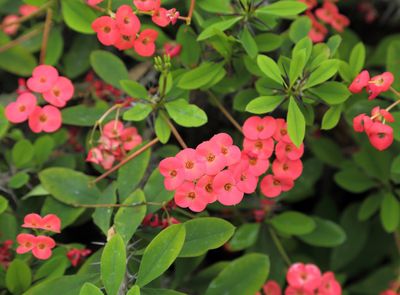My Crown of Thorns Has Spots
Crown of thorns is a semi-evergreen plant that produces small leaves, a lot of spiky thorns, and pretty little flowers throughout the year in warm climates. In colder climates, crown of thorns makes a good houseplant. Unfortunately, it can be impacted by a disease called bacterial leaf spot, caused by bacteria called Xanthomonas. Spotted crown of thorns plants may be suffering from this bacterial disease, but spots can also be caused by fungal infections and injury. To determine if the issue is bacterial leaf spot, look at the shape. This particular disease causes spots that follow the veins of the leaves. This pattern results in angular shapes to the spots, which are grayish brown and develop yellow haloes. The spots will be different sizes and shapes and occur unevenly on leaves. Over time they grow into each other, producing large areas of dead tissue.
Treating Crown of Thorns with Leaf Spot
If you have spotted crown of thorn plants and it seems to be bacterial leaf spot, it is important to remove affected leaves and plants and take steps to prevent spreading it to other plants. In addition to crown of thorns, this disease can infect poinsettias, geranium, zebra plant, and begonia. The disease is transferred from plant to plant or leaf to leaf by splashing water. Avoid overhead irrigation and be sure plants have enough space between them for airflow to allow leaves to dry and to reduce humidity. Disinfect any tools you use on diseased plants and destroy the affected leaves. Copper-containing sprays are, unfortunately, only partly effective in treating and controlling bacterial leaf spot on crown of thorns and other plants. You can try using it to protect plants that have not yet been affected, but good coverage is essential for the best results.
